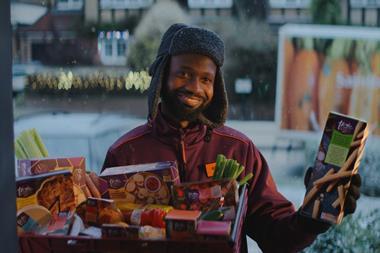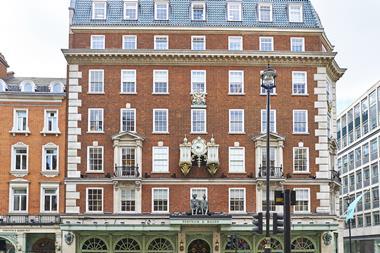F orget stodgy hash browns, greasy sausages and runny baked beans. A new generation of supermarket cafe is typified by a trial at Sainsbury's London Colney. It has a fruit smoothie bar, soft armchair seating and access to wi-fi. The mezzanine level space, complete with muted burgundy walls, is a long way from the supermarket cafeteria of old.
Research conducted in 2006 by food and grocery intelligence specialist IGD found that only one in 10 consumers regularly visit supermarket cafes. The current figure for Sainsbury's store customers visiting its cafes is even smaller than that - only 6% of customers bother to stop for coffee according to head of foodservice Julia Hatcher. Only now is the penny dropping at Sainsbury's and other retailers: store cafes can add significantly to profit margins if care is taken to get the offer right.
"Three years ago the cafes were completely underinvested," says Julia Hatcher. "They were dated. We wanted a high-street-style coffee bar with supermarket prices and that is what we have been starting to deliver. Now I head a team of cafe experts. All our new stores will get new cafes." Currently Sainsbury's eateries contribute just 1% of the revenue to main store sales but management is beginning to recognise that cafes could add more than just sales in the future. Hatcher describes a cafe as offering a 'halo effect'.
"The 'halo effect' can affect overall store sales by up to 15%. Nearly every visitor to the cafe will also use the store," she says. "Some people will come to a store for the total experience and that includes going to the cafe. It's a showcase for our corporate brand and customers can sample those values while in the store."
Analysts also buy into the logic. "Customers are fundamentally not going to supermarkets for a coffee," says analyst Greg Lawless at Blue Oar Securities. "But they may decide to make shopping more of an event. It's part of the proposition. It increases the attractiveness of the store."
IGD's research noted that the UK high street- branded cafe market was growing exponentially in 2006, a trend that continues apace. The report suggested the retail industry should consider the opportunity for developing the supermarket cafe further by 'premiumising' the experience and harnessing the positive associations consumers have about the food and drink sold in stores," it says.
To some retailers, this is old news. The higher-end supermarkets are already attracting consumers to their cafes. Waitrose leases five coffee shop concessions to Whitbread's Costa brand but the remainder of its portfolio benefits from 50 cafes of its own. Its largest store - Canary Wharf Food & Home - houses eight eateries including a steak & oysters bar. "Contrary to IGD's findings, our coffee shops are popular with customers and receive a 10% sales increase year-on-year," says spokeswoman Suzanne Cronin. "The menus in these cafes use food and drink from the suppliers we use for our products, so the cafes reflect Waitrose principles."
Marks & Spencer also feels it has its formula right. Its cafes are the third-biggest coffee chain in the UK. The 'M&S café', which used to be called 'café Revive' but was rebranded after the majority of its customers referred to it as the former, employs trained baristas in its 235 outlets. The chain also has four restaurants, two M&S kitchens and an oyster bar at the High Street Kensington branch. The restaurants serve seasonal food, predominantly cooked from scratch, explains a spokeswoman. Meanwhile the cafes serve up similar fare to that of Starbucks or Pret with fruit smoothies, sandwiches, pastries and coffee made "with M&S quality".
Not all retailers feel the same about the importance of a cafe. Tesco is currently replacing many of its cafes - run by contract caterer Eurest - with Costa concessions to provide more shop floor space. Analysts feel cafes run by outsiders will add less revenue than those retailers run themselves in the future, but Tesco doesn't care. "Our cafes have seen gradual decline in the past few years," says a spokesman, "and we feel the space is better used for more non-food and fresh produce, which customers are demanding".
The Tesco stance serves only to remind those who are choosing to grow their cafe offer, that the space needs to work hard for the retailers to ensure they add to margins. That can be as much about matching the café environment to customer demographics as it does to the food offer. Currently 50% of spend in cafes at Sainsbury's comes from people over 55 according to Hatcher.
"There are a lot of customers we're not tapping into," she says. "We are looking into what our cafe of the future might be. It's about providing the store with a better cafe environment. We need to think about the concept and offer something along the lines of Pret or Eat, where there is food to go."
Another question under consideration is whether to apply different cafe formats or a one-size-fits-all ethos. The coffee bar at Sainsbury's in London Colney is one of a number of formats the retailer runs, on top of 38 Starbucks concessions in its branches. Sainsbury's also has breakfast bars, and 'serveover cafes' offering more substantial dishes such as macaroni cheese, fish and chips and chicken tikka.
"For convenience stores, cafes are not as relevant as they are for bigger stores where people come in for a couple of hours to browse. Then there are stores, usually in London, where however fantastic the offer is, customers won't have time to come in and sit down. We put Starbucks in London stores. We wouldn't put Starbucks, for example, in Swatham in Norfolk because it wouldn't be appropriate."
Asda is similarly pragmatic. Only 190 of its 354 stores include a cafe, but the intention is to have one in every store. And while the bestselling item on the menu is the value breakfast at £1.75, it is trialling different formats in smaller stores to see what works.
Morrisons takes a different approach again, preferring to showcase its products. "Our cafe range uses products customers can purchase in-store, including our Organic and The Best ranges," says a spokeswoman. "In addition, we use specialist foodservice suppliers to enable us to offer our customers restaurant quality at a great price. We constantly update and refresh our menus to offer a wide choice of dishes, cooked to order and served to the table."
This, Lawless believes, helps put Morrisons ahead of the other store chains. "They give a full restaurant offer and are entrepreneurial in the way they manage their surplus," he says. "They might use surplus pineapples on a pizza. I would hold them up as one of the better operations."
Such planning is closer to the model used by smaller independents that sell the same items in their cafes and delis as they do on their shelves and use up surplus produce in cooked dishes. "Cafes can increase the time the customer spends in the store and create another reason to visit," says IGD senior business analyst Gavin Rothwell, two years after he authored the cafe culture report. "They take up valuable space but if managed properly, the margins can be good."n

















No comments yet